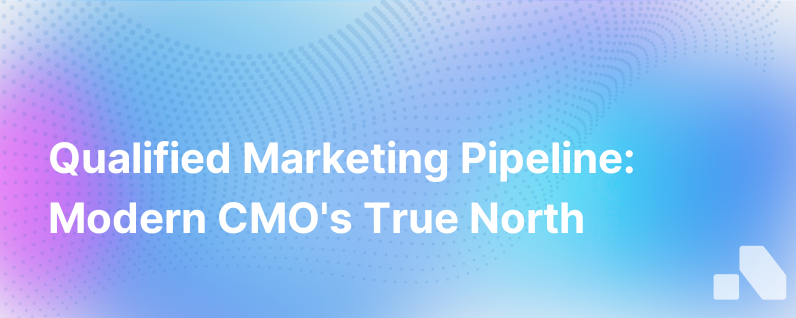
In today's dynamic business environment, steering marketing efforts towards qualified pipeline generation is the beacon that guides Chief Marketing Officers (CMOs) towards success. As digital transformation accelerates across industries, the role of the CMO has undergone a profound shift, evolving from a focus on top-of-funnel branding and awareness activities to a laser focus on measurable outcomes and revenue generation. This evolution underscores the growing recognition that a qualified marketing pipeline is the true north for the modern CMO.
The Traditional Marketing Paradigm
Traditionally, marketing departments have been viewed as cost centers responsible for crafting brand narratives, boosting brand visibility, and generating a high volume of leads. While those functions remain crucial, there has been a paradigm shift. The plethora of channels available today, the sophistication of marketing technologies, and the changing behavior of customers have paved the way for a more nuanced and outcome-oriented approach to marketing.
The Shift to a Qualified Marketing Pipeline
A qualified marketing pipeline aligns marketing activities more closely with sales, focusing on moving identified prospects through a funnel towards a sale. It prioritizes the quality of leads over sheer quantity, ensuring that resources are invested where they can make the most significant impact on the company's bottom line.
Why is the Qualified Marketing Pipeline Critical?
-
Optimization of Marketing Spend: Each marketing dollar must be scrutinized and optimized to generate the highest possible return on investment. Spending on activities that fill the funnel with unqualified leads is not only wastereful but can also strain the sales and marketing relationship.
-
Alignment with Sales: Modern marketing organizations work hand-in-hand with sales teams. The more marketing focuses on delivering sales-ready leads, the smoother the handoff process and the faster the sales cycle.
-
Data-Driven Decision-Making: With advanced analytics tools and CRM systems, CMOs can now leverage data to drive decisions, pinpoint the most effective strategies, and predict future performance with greater accuracy.
-
Improved Accountability: By targeting qualified leads, marketing departments can demonstrate their contribution to revenue, attributing marketing efforts directly to closed deals and customer acquisition.
-
Enhanced Customer Experiences: A qualified pipeline strategy requires a deep understanding of customer needs, leading to more personalized and targeted campaigns that resonate with prospects and enhance the overall customer experience.
The Pillars of Building a Qualified Marketing Pipeline
A successful qualified marketing pipeline rests on several foundational pillars. Here's how modern CMOs can build and refine their approach:
-
Strategic Targeting and Segmentation: Leverage buyer personas, demographic data, and behavior analytics to identify the highest potential prospects and understand their purchase journey.
-
Content Marketing Excellence: Produce relevant, engaging, and valuable content that addresses customer pain points and nurtures leads through the pipeline stages.
-
Lead Scoring and Qualification: Implement a sophisticated lead scoring system to filter and prioritize leads based on their likelihood to convert.
-
Technology and Automation: Embrace marketing automation tools to streamline processes, score leads, and deliver timely content, ensuring consistent engagement with prospects.
-
Sales and Marketing Alignment: Regularly sync with the sales team to ensure that marketing objectives and sales goals are in harmony, and to fine-tune the lead qualification criteria.
-
Performance Measurement: Monitor key performance indicators (KPIs) such as Marketing Qualified Leads (MQLs), Sales Qualified Leads (SQLs), and conversion rates to track progress and make necessary adjustments.
-
Customer Insights: Continuously gather and analyze customer feedback to refine buyer personas and targeting strategies, ensuring pipeline activities remain relevant and effective.
Challenges and Solutions
While the focus on the qualified marketing pipeline is pivotal, CMOs may face challenges in execution:
-
Data Overload: The volume of data can be overwhelming. Solution: Invest in robust CRM and analytics platforms and talent that can translate data into actionable insights.
-
Sales-Marketing Misalignment: In some organizations, alignment is still an issue. Solution: Implement collaborative Service Level Agreements (SLAs) and nurture a culture of cooperation.
-
Adaptability: Market dynamics change rapidly. Solution: Stay agile with marketing strategies, embracing a test-and-learn methodology.
-
Technology Integration: Fragmented marketing technology stacks can impede success. Solution: Opt for integrated solutions and platforms that provide coherent data and user experiences.
Aomni: An Ally in the Quest for a Qualified Pipeline
As CMOs navigate through these challenges and opportunities, they require tools that can give them a competitive edge. Aomni, an AI-driven platform for B2B sales, is designed to align with the needs of the modern CMO. This platform offers real-time insights, helping marketing teams develop a deeper understanding of accounts and providing actionable data for content personalization.
In conclusion, the modern CMO's north star shines brightly over a qualified marketing pipeline. It represents a strategic, data-driven, and results-focused approach that fuels not just business growth but also customer-focused innovation. Embracing these new paradigms, technologies, and strategies, today's CMOs can navigate their organizations towards a prosperous and customer-centric future.